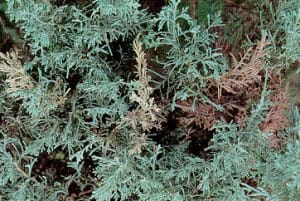Source(s):
- Austin Hagen, Extension Plant Pathologist, Auburn University.
- Jacquelin Mullen, Extension Plant Pathologist, Auburn University.
- Jean Williams-Woodward, Extension Plant Pathologist, The University of Georgia.
Phomopsis twig blight, which is caused by the fungus Phomopsis juniperovora, is a common and damaging disease of arborvitae, cypress, juniper, red cedar and related evergreens. Varieties of juniper most susceptible to Phomopsis blight include J. sabina var. tamarisfolia, “Nicks Compact Pfitzer”, “Andorra”, “Bar Harbor” and “Blue Rug.” Frequent shearing and heavy fertilization with nitrogen may increase the severity of Phomopsis blight.
Symptoms
In late spring and through the summer, diseased shoot tips, that at first are light green in color, quickly turn yellow and then brown. The browning may spread down the shoot several inches from the tip. Gray cankers, which mark the original infection sites, often girdle the smaller shoots causing a twig dieback. Tiny black fruiting bodies (pycnidia) of the causal fungus may be seen on the gray cankers with a hand lens. Blighting is often seen first on the lower, inside branches. While seedling and container-grown junipers and red cedar may be disfigured or killed by Phomopsis blight, damage on junipers in landscape plantings is unsightly but rarely serious.
Persistence and Transmission
The causal fungus overwinters in cankers on diseased shoots. In late spring, masses of spores ooze from the fruiting bodies during wet, humid weather. Spores are spread to healthy shoots by splashing water or on pruning shears. Continuously wet foliage is needed for infection to occur. With favorable temperatures, the longer the foliage is wet, the more severe the symptoms. Soft, young shoots are much more sensitive to attack than mature foliage.
Control: Phomopsis blight is best controlled by using the following strategies:
Non-Chemical Control
- Planting resistant cultivars is the most effective practice for controlling Phomopsis blight in landscape plantings on juniper.
- Purchase junipers with good color and no dead or dying shoots.
- Avoid planting junipers in heavy shade or on poorly drained sites.
- Prune and space plants properly to encourage good air circulation and rapid drying of foliage.
- Irrigate with overhead sprinklers in the morning or early afternoon to ensure that the foliage dries before nightfall. Avoid irrigating in the late evening or at night when foliage will not dry quickly.
- Do not handle or prune wet plants.
- Avoid injuries, such as mower damage.
- Prune out diseased shoots as soon as they appear, but only when plants are dry. Make pruning cuts 3 inches below dead or dying tissue and then discard the diseased shoots.
Chemical Control
For effective prevention and control, a fungicide treatment program should start shortly after shoot growth has begun or anytime after pruning, and before symptoms are seen. In landscape plantings, additional applications should be made about every 14 days until the new growth matures in early to mid-summer. Always refer to the product label for information concerning application rates, directions, and precautions before applying any fungicide. See the Georgia Pest Management Handbook for current disease control recommendations.
Resistance to Phomopsis has been identified in juniper species. Results of resistance field trials may differ, but in general some Phomopsis-tolerant Juniperus species and cultivars include: J. chinensis cultivars ‘Iowa’, ‘Keteleeri’, ‘Pfitzeriana aurea’, ‘Robusta’, ‘var. Sargentii’, ‘Sargentii glauca’, and ‘Shoosmith’; and J. virginiana cultivars ‘Hillii’ and ‘Tripartita’. Cultivars and species of junipers that are susceptible to Phomopsis blight include: J. horizontalis cultivars ‘Bar Harbor’, ‘Blue Chip’, ‘Blue Horizon’, ‘Blue Mat’, ‘Emerson’, ‘Plumosa compacta’, ‘Prince of Wales’, ‘Procumbens’, and ‘Wiltonii (Blue Rug)’; J. chinensis cultivar ‘Spartan’; and J. conferta cultivars ‘Emerald Sea’ and ‘Blue Pacific’.
Resource(s):
Common Landscape Diseases In Georgia
Center Publication Number: 215
